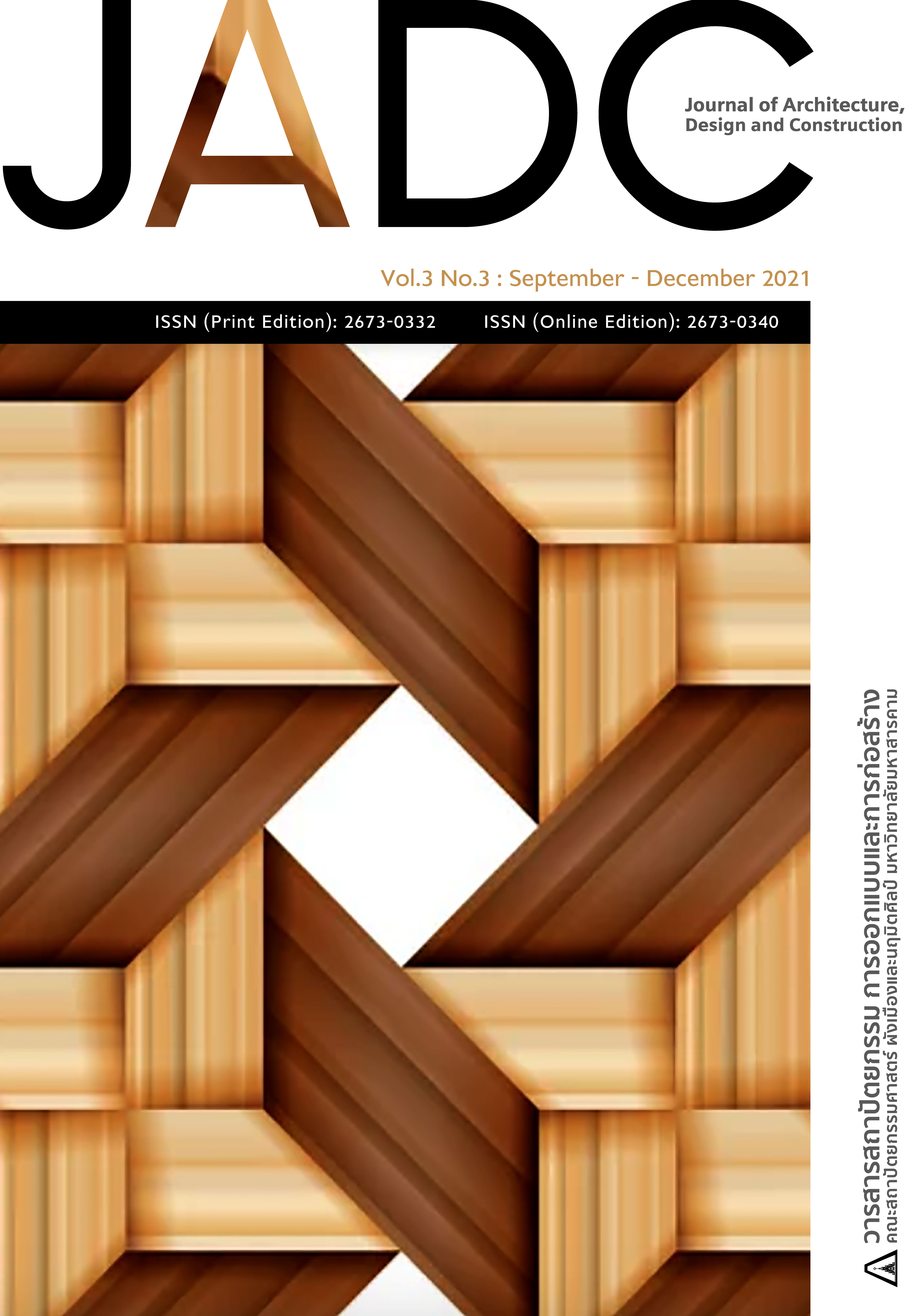การเปรียบเทียบผลของแรงลมที่มีต่อโครงสร้าง อาคารพักอาศัยรวม สูง 4 ชั้น
Main Article Content
บทคัดย่อ
งานวิจัยนี้ได้ศึกษาผลการวิเคราะห์ผลของแรงลมต่ออาคารพักอาศัยรวม 4 ชั้น โดยทำการเปรียบเทียบในเรื่องขนาดของแรงลมจากพระราชบัญญัติควบคุมอาคารกรุงเทพมหานคร ฉบับที่ 6 พ.ศ.2522 กับขนาดแรงลมตามมาตรฐานของกรมโยธาธิการและผังเมือง (มยผ.1311-50) โดยอาคารที่ทำการศึกษาเป็นอาคารที่ตั้งอยู่ในสภาพภูมิประเทศแบบ B คือตั้งอยู่ในชุมชนขนาดเล็ก มีต้นไม้และอาคารข้างเคียง และเปรียบเทียบผลของแรงภายใน ราคาค่าก่อสร้างงานโครงสร้างเสา คาน พื้นอาคาร ภายใต้แรงกระทำทางดิ่งจากน้ำหนักบรรทุกคงที่ น้ำหนักบรรทุกจร และแรงกระทำด้านข้างจากแรงลม จากการวิเคราะห์โครงสร้างพบว่า หน่วยแรงลมตามมาตรฐานของกรมโยธาธิการและผังเมือง มีขนาดน้อยกว่าหน่วยแรงลมตามพระราชบัญญัติควบคุมอาคาร กรุงเทพมหานคร ฉบับที่ 6 พ.ศ.2522 และเมื่อนำขนาดของหน่วยแรงลมมากระทำต่ออาคารที่ทำการศึกษา เปรียบเทียบกับอาคารที่ไม่พิจารณาแรงลมพบว่า ในด้านแรงภายใน คือโมเมนต์ดัด และแรงเฉือนเพิ่มขึ้น 1.5 และ 1.3 เท่า ด้านราคาก่อสร้าง เพิ่มขึ้นร้อยละ 1.1 และ 1.0 โดยใช้หน่วยแรงลมตามพระราชบัญญัติควบคุมอาคาร กรุงเทพมหานคร พ.ศ.2522 และหน่วยแรงลมตามมาตรฐานของกรมโยธาธิการ และผังเมืองตามลำดับ แต่เมื่อใช้ตัวคูณลดค่าในกรณีที่พิจารณาแรงลม ตามมาตรฐานของวิศวกรรมสถานแห่งประเทศไทย (ว.ส.ท) ค่าหน่วยแรงที่เกิดขึ้น ขนาดของหน้าตัด ขนาดและจำนวนของเหล็กเสริมของโครงสร้างเสา จะลดลงมาใกล้เคียงกันกับกรณีที่ไม่พิจารณาแรงลม โดยทำให้ราคาค่าก่อสร้างลดลงมาเหลือแตกต่างกันเพียงร้อยละ 0.4 และ 0.1 เท่านั้น
Downloads
Article Details

อนุญาตภายใต้เงื่อนไข Creative Commons Attribution-NonCommercial-NoDerivatives 4.0 International License.
บทความที่ได้รับการตีพิมพ์เป็นลิขสิทธิ์ของวารสารสถาปัตยกรรม การออกแบบและการก่อสร้าง คณะสถาปัตยกรรมศาสตร์ ผังเมืองและนฤมิตศิลป์ มหาวิทยาลัยมหาสารคาม
เอกสารอ้างอิง
วันดี พินิจวรสิน และสายทิวา รามสูต. (2011). ความต้องการของผู้มีรายได้ปานกลางในเขต กรุงเทพมหานคร และปริมณฑลที่มีต่อคุณลักษณะบ้านเดี่ยว. NAJUA: Architecture, Design and Built Environment, 25, 365-365.
มนนภา เทพสุด. (2019). ภาวะโลกร้อน:ผลลัพธ์เชิงลบในโลกยุคอุตสาหกรรม. มหาวิทยาลัยศรีปทุม.
กรมโยธาธิการและผังเมือง. 2560. มาตรฐานการคำนวณแรงลมและการตอบสนองของอาคาร (มยผ.1311-50). กรมโยธาธิการและผังเมือง กระทราวงมหาดไทย)
กฎกระทรวง ฉบับที่ 6 (2527). ออกตามความในพระราชบัญญัติควบคุมอาคาร พ.ศ. 2522.
Francom, T. C. and El Asmar, M. (2015). Project quality and change performance differences associated with the use of building information modeling in design and construction projects: Univariate and multivariate analyses. Journal of Construction Engineering and Management, 141(9), 04015028.
Chitkara, K. K. (1998). Construction project management. Tata McGraw-Hill Education.
Lester, A. (2006). Project management, planning and control: managing engineering, construction, and manufacturing projects to PMI, APM and BSI standards. Elsevier.
Chaitongrat,T., Leungbootnak, N., Kusonkhum, W., Deewong,W., Srinavin, K.. (2019). Measurement model of good governance in government procurement. IOP Conference Series Materials Science and Engineering 639:012024. 639(1), 0120204.
Jervis, B.M.; Levin, P. Construction law, principles, and practice. McGraw-Hill College, 1988
Teanngen, B., Kusonkhum, W., Liwthaisong, S., Chaitongrat,T., and Srinavin, K. (2020). Risk factors affecting conflict management for construction government project in Thailand. Multidisciplinary Technologies for Industrial Applications, 2020, pp. 94–105, doi: https://doi.org/10.13052/rp-9788770225823.
พระราชบัญญัติการจัดซื้อจัดจ้างและการบริหารพัสดุภาครัฐ พ.ศ. 2560. (2560). กรุงเทพฯ : กรมบัญชีกลาง.
แนวทางประกาศรายละเอียดข้อมูลราคากลางและการคำนวฯราคากลางเกี่ยวกับการจัดซื้องจัดจ้างของหน่วยงานของรัฐ. (2562). กรุงเทพฯ : กรมบัญชีกลาง.
Burke, R. (2013). Project management: planning and control techniques. New Jersey, USA, 2013; pp. 26.
Cooper, D. F., MacDonald, D. H., and Chapman, C. B. (1985). Risk analysis of a construction cost estimate. International journal of project management, 3(3), 141-149.
PMI, A. (2013). guide to the project management body of knowledge (PMBOK guide). In Project Management Institute (Vol. 5).


